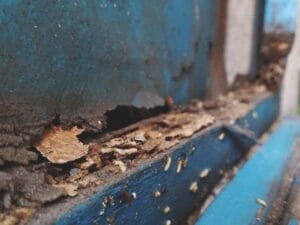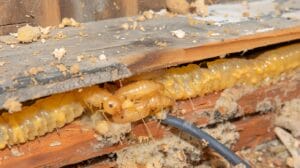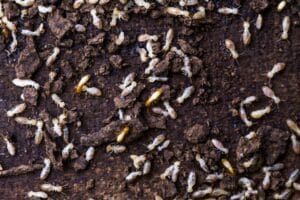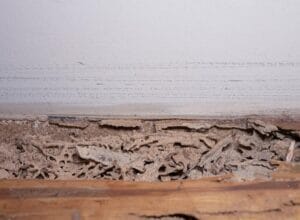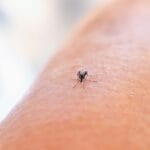Key Takeaways
- Bait systems and barrier methods are two effective strategies for termite prevention and control.
- Bait systems work by attracting termites to feed on poisoned bait, which they then carry back to the colony.
- Barrier methods involve applying a chemical treatment to the soil around a home to create a deterrent or lethal barrier.
- While bait systems are more environmentally friendly and less intrusive, they can take longer to eliminate a colony.
- Barrier methods offer immediate protection but may have a greater environmental impact and require professional installation.
Unlocking the Secrets to a Termite-Free Home
When it comes to keeping your home safe from the silent destroyers known as termites, you have to be both strategic and informed. These pests can cause extensive damage before you even realize they’re there, so choosing the right treatment method is crucial. Let’s delve into the two most popular approaches: bait systems and barrier methods. Understanding the nuances of each will empower you to make the best decision for your home.
Bait System Basics
Think of bait systems as a clever trap. These systems don’t just kill the termites that stumble upon them; they turn these termites into carriers of doom for their entire colony. The bait is designed to be irresistible to termites, and once they find it, they’ll bring it back to share, unknowingly spreading poison through the colony. It’s a domino effect that leads to the collapse of the termite population threatening your home.
Barrier Method Breakdown
On the other side, we have the barrier method. This is like building a moat around your castle. Chemicals are applied to the soil to create a protective shield that termites cannot cross. If they try, they’re either repelled or eliminated. It’s a straightforward defense mechanism that has stood the test of time.
But let’s not just scratch the surface. To truly protect your home, you need to understand the strengths and limitations of each termite treatment method.
Baiting Termites: A Stealthy Strategy
Bait systems are not a quick fix. They require patience, but their strategic approach to termite control is a game-changer. Instead of a full-frontal assault, bait systems use the termites’ own behavior against them, leading to the eventual downfall of the entire colony. It’s a war of attrition, and with the right setup, victory is often assured.
How Termite Bait Systems Work
Bait systems are all about the long game. Here’s how they work:
- Installation: Stations containing wood or another cellulose-based material are placed around your home’s perimeter.
- Attraction: Termites are naturally drawn to these stations as a food source.
- Poisoning: Once termite activity is confirmed, the wood is replaced with bait containing a slow-acting poison.
- Elimination: Termites feed on the poisoned bait and share it with the colony, leading to a gradual but comprehensive kill-off.
It’s a clever strategy that takes advantage of the termites’ natural behaviors, ensuring that the poison reaches deep into the heart of the colony, even if it’s located far from the bait station.
The Pros of Bait Systems
The advantages of bait systems are significant:
- Environmental Safety: They use less pesticide than barrier methods, which is better for the environment.
- Non-Disruptive: Installation and maintenance of bait stations are minimally invasive, with no need for drilling or trenching.
- Targeted Approach: Bait systems specifically target termites, reducing the risk to other wildlife or pets.
Because of these benefits, bait systems are often the preferred choice for those looking for a more environmentally conscious solution.
The Cons: Patience Required
However, bait systems are not without their drawbacks:
- Time: It can take months for the bait to affect the entire colony, during which time termites can continue to damage your home.
- Maintenance: Bait stations need regular inspection and maintenance to ensure they remain effective.
- Initial Ineffectiveness: If the termite infestation is already advanced, bait systems may not be able to keep pace with the damage being done.
When considering a bait system, it’s crucial to weigh these factors against the potential benefits. For more information on termite infestation and control, you can read our detailed guide on termite infestation costs and prevention.
Advantages of Barrier Protection
Barrier methods are like a sturdy shield for your home. They provide immediate protection from termites by creating a chemical barrier in the soil. This method is proactive, stopping termites in their tracks before they can even start thinking about making a meal out of your home. It’s an aggressive defense tactic that ensures termites don’t stand a chance from the get-go.
The chemical used in barrier treatments is designed to either repel termites or kill them upon contact. This method can be particularly effective if you’re dealing with a current infestation, as it stops additional termites from joining the party and helps to eliminate those already present.
Potential Downsides of Chemical Use
However, with great power comes great responsibility. Chemical barriers are potent, and that means they come with their own set of considerations:
- Chemical Exposure: The use of pesticides raises concerns about the safety of humans and pets, especially if not applied correctly.
- Environmental Impact: Chemical treatments can affect more than just termites, potentially harming beneficial soil organisms and affecting the ecosystem.
- Professional Application: Due to the nature of the chemicals, professional application is usually required, which can add to the cost and complexity.
It’s crucial to consider these factors when deciding on a termite treatment plan, as the safety of your family and the environment should always be a priority.
Comparing Costs: Spending Now to Save Later
Let’s talk about the elephant in the room: cost. Both bait systems and barrier methods involve an investment, but it’s an investment that could save you thousands of dollars in home repairs down the line. It’s essential to look at both the short-term and long-term costs associated with each method.
Upfront Investments and Long-Term Savings
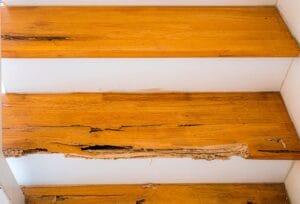
Bait systems may seem more expensive initially due to the cost of the bait stations and the ongoing maintenance they require. However, consider this: bait systems can be more cost-effective in the long run if they prevent extensive termite damage by eliminating the colony.
Barrier treatments, while offering immediate protection, may require reapplication every few years, depending on the product used. This means that while the initial outlay might be lower, over time, you could end up paying more for continued protection.
Installation: DIY Versus Professional Services
When it comes to installation, there’s a stark difference between the two methods:
- DIY Bait Stations: Some homeowners may feel comfortable installing and monitoring bait stations themselves.
- Professional Barrier Application: Chemical barriers, on the other hand, almost always require professional application to ensure safety and effectiveness.
While DIY might seem like a way to save money, remember that professional services come with expertise that can be the difference between a termite-free home and an ongoing battle.
Efficacy Over Time: Bait Systems and Barriers
So, how do these methods stack up over time? Effectiveness is not just about the immediate impact; it’s about ensuring that termites don’t become a recurring nightmare.
Longevity of Bait Systems
Bait systems are a long-term solution. They’re designed to be maintained and monitored over time, which means they can continue to protect your home as long as you keep up with the necessary checks and refills. This ongoing vigilance can be a small price to pay for peace of mind.
Remember, though, that bait systems rely on the termites finding the bait. This means that new colonies or those that have not yet encountered the bait can still pose a threat.
How Long Barrier Treatments Last
Barrier treatments have a more finite lifespan. Typically, they’re effective for around 5 to 10 years, depending on the product and environmental conditions. Regular inspections are still crucial, as even the best chemical barrier can be breached by persistent termites or disrupted by construction, erosion, or heavy rainfall.
- Regular inspections are key to both methods, ensuring that any breaches or failures are caught early.
- Reapplication of barrier treatments is necessary every few years, which can add to the long-term cost.
- Bait systems require ongoing monitoring and replenishment but offer continuous protection if maintained.
Ultimately, the efficacy of these treatments over time will depend on consistent maintenance and vigilance.
Environmental Considerations
In today’s world, the environmental impact of our choices is more important than ever. Termite treatments are no exception, and it’s crucial to consider the ecological footprint of the methods you choose.
Eco-Friendly Termite Control Options
For those looking for eco-friendly termite control options, bait systems are often the preferred choice. They use targeted, low-toxicity bait that reduces the risk of affecting non-target species and minimizes chemical use.
Barrier methods, while effective, use broader-spectrum chemicals that can affect other soil organisms and potentially seep into groundwater if not applied correctly.
It’s also worth exploring newer, greener alternatives to traditional chemical barriers, such as physical barriers made from materials that termites can’t penetrate.
Assessing the Ecological Impact
When assessing the ecological impact of termite treatments, consider the following:
- Soil Health: Chemical barriers can affect soil organisms, which play a crucial role in soil health and the broader ecosystem.
- Water Safety: Pesticides can leach into groundwater, affecting water quality and aquatic life.
- Non-Target Species: Termite treatments should be selective, targeting only termites to minimize the impact on beneficial insects and animals.
By considering these factors, you can choose a termite treatment that not only protects your home but also respects the environment.
Case Studies: Real Homes, Real Results
Let’s look at real-life scenarios where homeowners faced termite threats and how they tackled them with either bait systems or barrier methods.
Success Stories with Bait Systems
A family in a suburban neighborhood noticed mud tubes along their foundation. They installed bait stations, and after several months, their termite problem was resolved without any noticeable damage to their lawn or garden, showcasing the system’s environmental friendliness.
Barrier Method Triumphs
In a coastal area prone to damp conditions, a homeowner applied a chemical barrier after a termite infestation was discovered. The immediate action taken prevented further damage, and subsequent annual inspections have kept the home termite-free for over five years.
Frequently Asked Questions (FAQ)
With termite control, homeowners often have a host of questions. Let’s address some of the most common concerns.
Can Termite Baits and Barriers Be Used Together?
Yes, combining bait systems with barrier treatments can offer comprehensive protection. The bait system manages the colony over time, while the barrier provides immediate defense, ensuring that your home is protected from all angles.
Are There Non-Toxic Options for Termite Control?
Indeed, there are non-toxic options such as borate treatments that can be applied to wood during construction, or physical barriers that can be installed. These methods can deter termites without the use of harmful chemicals.
What’s the Most Cost-Effective Termite Treatment?
Cost-effectiveness depends on several factors, including the severity of the infestation and the size of your property. Generally, bait systems are more cost-effective over time, while barrier methods might offer a more affordable upfront cost but require reapplication.
How Often Should Termite Treatments Be Reapplied?
Reapplication varies by treatment type. Bait stations should be checked and replenished as needed, typically every few months. Chemical barriers usually last for 5 to 10 years, but it’s essential to have annual inspections to ensure the barrier remains intact.
Can I Install a Barrier System Myself?
While some barrier treatments can be applied by homeowners, it is strongly recommended to use professional services due to the potential health risks and the expertise required to ensure effective application.
When considering termite treatment options, it’s essential to compare the effectiveness of bait systems versus barrier methods. Bait systems involve placing bait stations around the perimeter of a home to lure termites, which then carry the poison back to their colony, potentially eliminating the entire colony over time. On the other hand, barrier methods create a chemical or physical barrier around the home that termites cannot cross. Each method has its advantages and disadvantages in terms of cost, effectiveness, and environmental impact. Homeowners must weigh these factors carefully to decide which termite treatment is best for their situation. For more detailed information on termite infestation costs and prevention strategies, refer to this comprehensive guide on termite prevention vs. damage repair.
